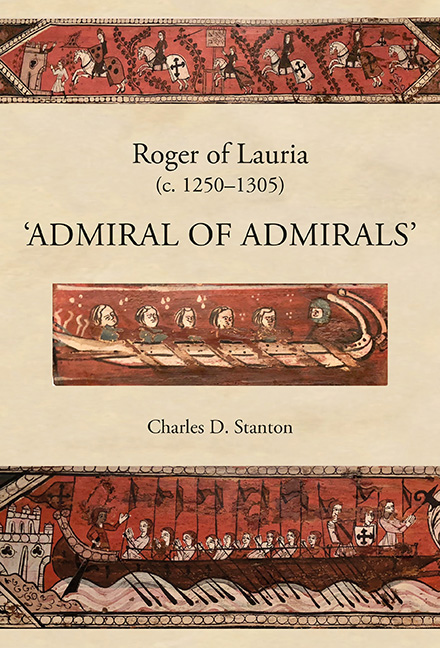Book contents
- Frontmatter
- Dedication
- Contents
- List of Illustrations
- Prologue
- 1 Battle of Benevento (26 February 1266)
- 2 A Calabrian Exile in the Court of Aragon (1262–1282)
- 3 Battle of Tagliacozzo (23 August 1268)
- 4 Aragonese Expansion (1229–1282)
- 5 Angevin Consolidation and Aggrandizement (1268–1282)
- 6 Revolt of the Vespers (30 March 1282)
- 7 Aragonese Intervention (August–October 1282)
- 8 Stalemate (November 1282–March 1283)
- 9 Admiral of Aragon (20 April 1283)
- 10 The Opposing Fleets (1282–1302)
- 11 Battle of Malta (8 June 1283)
- 12 Anjou's Dreams of Empire Dashed (June–November 1284)
- 13 France's Crusade Against Aragon (May–November 1285)
- 14 Battle of the Counts (23 June 1287)
- 15 Truces and Treaties (June 1287–November 1291)
- 16 Raid on Romania (Summer 1292)
- 17 Switching Sides (December 1293–April 1297)
- 18 Aragon's Invasion of Sicily at Anjou's Bidding (1298/1299)
- 19 Lauria's Last Great Campaign (Summer 1299–Spring 1300)
- 20 Endgame (Spring 1301–Summer 1302)
- Epilogue
- Bibliography
- Index
15 - Truces and Treaties (June 1287–November 1291)
Published online by Cambridge University Press: 24 October 2019
- Frontmatter
- Dedication
- Contents
- List of Illustrations
- Prologue
- 1 Battle of Benevento (26 February 1266)
- 2 A Calabrian Exile in the Court of Aragon (1262–1282)
- 3 Battle of Tagliacozzo (23 August 1268)
- 4 Aragonese Expansion (1229–1282)
- 5 Angevin Consolidation and Aggrandizement (1268–1282)
- 6 Revolt of the Vespers (30 March 1282)
- 7 Aragonese Intervention (August–October 1282)
- 8 Stalemate (November 1282–March 1283)
- 9 Admiral of Aragon (20 April 1283)
- 10 The Opposing Fleets (1282–1302)
- 11 Battle of Malta (8 June 1283)
- 12 Anjou's Dreams of Empire Dashed (June–November 1284)
- 13 France's Crusade Against Aragon (May–November 1285)
- 14 Battle of the Counts (23 June 1287)
- 15 Truces and Treaties (June 1287–November 1291)
- 16 Raid on Romania (Summer 1292)
- 17 Switching Sides (December 1293–April 1297)
- 18 Aragon's Invasion of Sicily at Anjou's Bidding (1298/1299)
- 19 Lauria's Last Great Campaign (Summer 1299–Spring 1300)
- 20 Endgame (Spring 1301–Summer 1302)
- Epilogue
- Bibliography
- Index
Summary
FOLLOWING THE BATTLE OF THE COUNTS, the war was transformed au fond by a fitful series of failed truces and treaties. Roger of Lauria, himself, inaugurated the process. Rather than subjecting Naples to the sack in the immediate aftermath of his triumph, as his Sicilian confederates would have wanted, he negotiated a truce with Robert of Artois and co-regent of the Regno, Cardinal Gerardo da Parma. Sicilian partisans such as Bartolomeo Neocastro were sharply critical of the pact, and some, like Niccolo Speciale, even considered it treasonous, but Lauria's professed loyalty was to the Crown of Aragon, not Sicily, and the circumstances strongly suggest that the admiral's diplomacy was at the behest of King Alfonso III. Along with the throne, Alfonso had inherited from his father all the crown's troubles with the Cortes. And the Cortes were no more supportive of the Sicilian adventure than they had been under the previous king; nor could they legitimately be compelled to do so, since the Crown of Aragon remained under papal anathema. In fact, rather than accede to the crown's appeals for more funding for the war, the Cortes reportedly dispatched envoys to France offering to recognize Charles of Valois as their liege lord in return for acknowledgment of their sovereign rights. Alfonso caved in to their demands on 20 December 1287 before anything could come of the overture, but the message was clear: he had to rid himself of this prolonged, coffer-draining conflict. Roger's truce with Robert of Artois was, thus, probably part and parcel of the process of disengagement, authorized by Alfonso himself.
For his part, Roger saw the negotiated ceasefire as a means of compensating his mariners, most of whom had not been paid for months. As was mentioned earlier, the exorbitant ransoms obtained as a result of the agreement satisfied that need. Seizing Naples was not a realistic option in any event. The fleet apparently possessed no siege machinery and, according to Mott, ‘was not organized for an amphibious operation against a large city’. Camillo Manfroni confirms this by noting that Lauria had to content himself with ‘devastating the neighboring lands, the Neapolitan islands and the cities of Sorrento and Castellammare’.
- Type
- Chapter
- Information
- Roger of Lauria (c.1250–1305)‘Admiral of Admirals’, pp. 210 - 222Publisher: Boydell & BrewerPrint publication year: 2019

